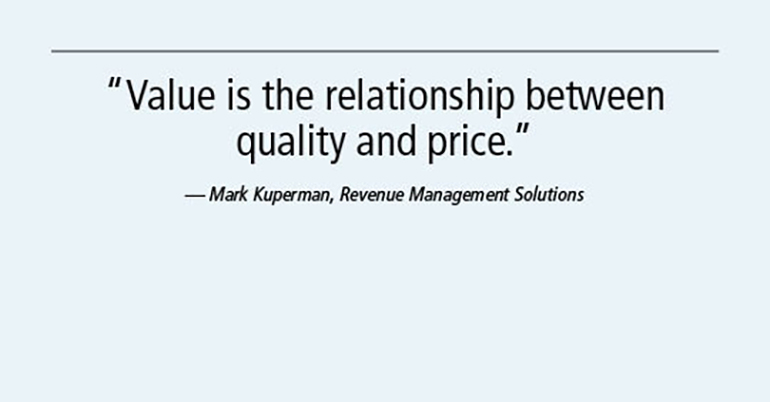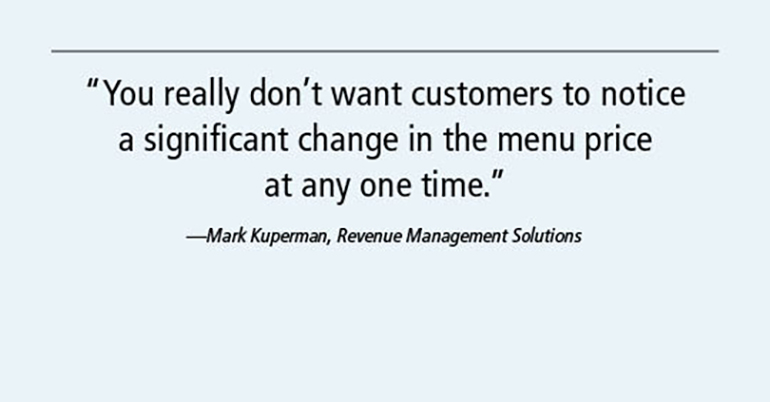With unemployment near record lows and minimum wage hikes going into effect in many jurisdictions, operators are under pressure to raise menu prices in order to remain profitable. But they have to do it while keeping their customers happy with what they’re paying. Regardless of the price, guests have to think they’re getting their money’s worth.

Value isn’t price
“Value is the relationship between quality and price,” said Mark Kuperman, chief operating officer of data analytics and services company Revenue Management Solutions. “Keeping those in balance, whether it’s a $5 item or an $18 item, is really critical.”
Keith Goldman, chief operating officer of California Tortilla, a 45-unit fast-casual chain based in Rockville, Md., said his customers “are always calculating that value equation in their head after each experience.
“They’re going to decide, ‘Hey, that was really a good meal and I really enjoyed being here and it was a good environment and it was clean and friendly. Yeah, that was worth $12.’ Or, they’re going to say: ‘That really wasn’t worth $12,’ and they didn’t eat all of their food and they didn’t have a great experience or someone was rude to them.”
Raising value without lowering price
Obviously great food and service and a clean restaurant are table stakes for successful operations, but California Tortilla is implementing new perks to appeal to their customers, including a new service model and proper plates and silverware.
Goldman said the chain is moving away from the traditional quick-service payment model that’s currently in place at California Tortilla, in which guests order and pay and then their burritos, bowls, tacos or quesadillas are assembled for them. Instead, the chain is implementing a “pay last” model, similar to many fast-casual chains, in which guests order, the food is assembled in front of them, and then they pay.
Goldman said the pay last model emphasizes the idea that everything is customizable. Of course, that has always been the case at California Tortilla, but making that fact more obvious to guests enhances perceived value, he said.
So does actual plateware, which the chain has been testing in company-owned restaurants and has rolled out at its new location in Chattanooga, Tenn.
He said that, although there are upfront costs of buying the dishes and silverware, as well as a dishwasher, the reduced use of paper makes it “cost neutral,” and also greener.
“And there’s a better feel to eating off of a real plate and with a real fork, and we’ve had lots of very positive comments about the change,” he said, adding that most of his franchisees have expressed interested in making the change.
“The brand has to evolve and we spend most of our time at corporate figuring out what is the evolution that needs to take place to keep us relevant and keep a new generation of customers trying us and becoming regular customers,” he said.

Lowering costs while maintaining quality
Making changes that add to perceived value can keep your customers happy in the face of price hikes, but trimming costs, or reworking the menu, can make price hikes less necessary, said Mike Sebazco, vice president of operations of Mooyah Burgers, Fries & Shakes. The Mooyah chain is based in Plano, Texas, with 70 domestic locations and 25 units in the Middle East.
Sebazco was part of the management team that took over Mooyah in 2017, and found that the chain offered customers great value for high-quality items.
“The third part of the equation that was left behind there was cost of goods,” he said. And that, of course, made it hard for operators to make ends meet.
So Sebazco worked to cut costs while maintaining quality. For example, he went through Mooyah’s process for making French fries in-house. Those house-made fries, and house-baked buns, are part of Mooyah’s value proposition, but in working with experts at the Idaho Potato Commission he found that there were steps they could take out that would save labor without affecting quality.
“We were doing some things that just weren’t relevant to producing quality,” he said. “There were things we believed were valuable to the process that accomplished nothing.”
He declined to provide further details, saying he needed to protect trade secrets.
Then there was the menu itself, which had 13 “pre-builds,” or burgers with popular combinations of toppings that the previous owners hoped would speed up the production process by not making their customers customize the burgers themselves.
“That just wasn’t the case,” Sebazco said, because guests also customized the pre-builds, which were introduced at a lower price than they would have been if customers built them from scratch.
So he reduced the pre-builds from 13 to 4 or 5, depending on the franchisee, and encouraged franchisees to price them as if they were custom-made.
Then, a year ago, Sebazco and his team got rid of chicken.
“If someone comes for the first time to Mooyah and they’re feeling fat that day and they order a chicken sandwich, it’s on our bun, it’s served with our fries, but the fact of the matter is it’s the same chicken sandwich you can get literally anywhere,” he said.
“The point of differentiation for us is … the burger.
“We’re confident that any burger-loving guest that walks in, if they order the Mooyah Double Cheeseburger, we’re going to [get them to return].”
Bailey McGuire, a franchisee with two Mooyah locations in Fort Worth, Texas, said he wasn’t thrilled with the idea right away.
“When Mike and his team said, ‘Hey, we’re going to reduce the menu by quite a few items,’ it wasn’t taken well. It was a leap of faith from the franchise community,” he said.
But as a result of the changes, Sebazco said that lower food cost, combined with labor cost improvements, have given 1,000 basis points back to franchisees.
“That’s 10% of their P&L,” he said, referring to the profit and loss statement.
Additionally, faster service times has resulted in a 6% increase in traffic, Sebazco said.

Smart price hikes
If you do have to raise prices, do it strategically, said Kuperman of Revenue Management Solutions.
“You really don’t want customers to notice a significant change in the menu price at any one time,” he said.
So if you’re going to raise prices to compensate for minimum wage hikes, Kuperman suggests doing so in two or three rounds rather than doing it all at once.
Also, don’t raise prices on items that customers are likely to buy together. Using a typical quick-service menu as an example, instead of raising prices on burgers, fries and drinks all at once, raise prices on all of the sandwiches at the same time, and then raise prices on drinks separately, and sides later on.
“They know what customers are buying together, and they should really take advantage of that,” he said.
Knowing your competition
Similarly, when sizing up competitors and their pricing, don’t do it item by item, but check by check.
Kuperman said customers are unlikely to remember the exact price of a Caesar salad, but they will have an idea of how much their meal cost.
“Maybe you want to look at [the price of] an appetizer, two entrées and a dessert and make sure that when that final bill comes that you’re not looking at a $15 difference in the check — something that’s really going to stand out to a customer,” he said.
And remember, you might have different competitors near different locations.
McGuire, the Mooyah franchisee, had a competitor near one of his restaurants “with very affordable kids meals,” he said.
“I don’t want to lose out to them when it comes to kids, so I’m going to reduce my kids meal prices just because of that competitor.”
But at his second location, no such competitor exists, so he left the kids’ prices there alone.
Reconsider your LTOs
You can also help manage costs with limited-time offers, said Justin McCoy, vice president of marketing for Cousins Subs, a chain of about 100 units based in Milwaukee, Wis.
“Ham and provolone is a staple [sandwich] and a top seller, and if the pork market moves we can only have so much [price] movement with a product like [ham] that’s on a number of subs and one of our most popular items,” he said.
However, he might avoid pork-related limited time offers until pork prices come back down.
Since Cousins is nearly 50 years old, McCoy said they have an idea of how price changes have affected sales in the past.
“We try to be a good judge of the propensity of our guests and what they’re willing to pay for the products we offer,” he said.
But he said he doesn’t want Cousins to be the cheapest place to go for a sub.
“Our value proposition is not on being the cheapest price, but on having the highest-quality product,” he said.
Contact Bret Thorn at [email protected]
Follow him on Twitter: @foodwriterdiary

